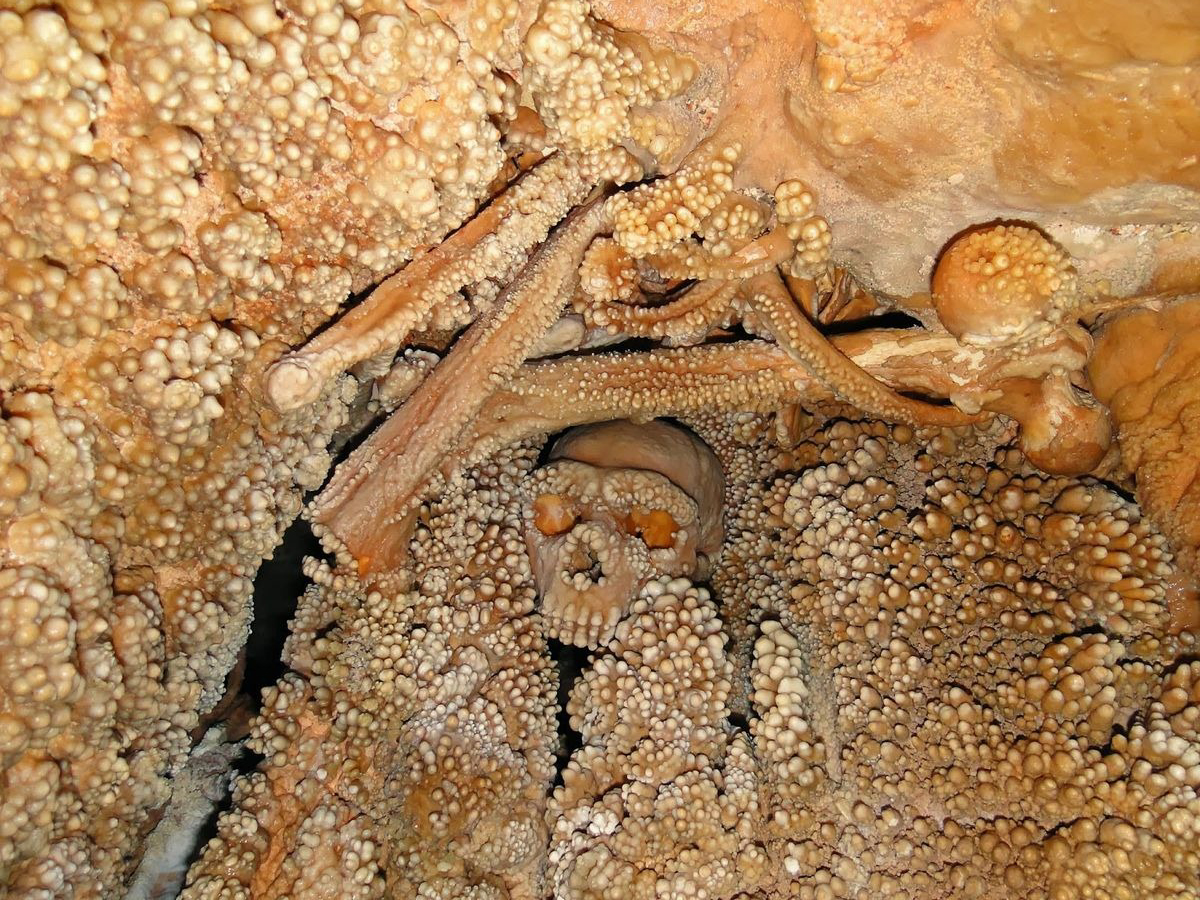The Altamura Man lived more than 130,000 years ago when ice sheets were expanding from out of Antarctica and Greenland. His fossilized skeleton imprisoned in calcite formations remained hidden from view at the bottom of a sinkhole near Altamura, a town in southern Italy, for many years. It was not until 1993 that the remains of the Altamura Man were unearthed in a cave.

The Altamura Man. Credit: Redazione Research Italy
His body was lying in an inaccessible location, and frustrated scientists had difficulties getting to his remains.
The body remains were stuck in a small chamber deep in the karst cave system.
“They used the rope to bring me down and many of my colleagues. For me, it was a totally amazing experience. When you get in that corner and you see the skeleton there, you’re really blown away,” said Jacopo Moggi-Cecchi, a professor in the department of biology at the University of Florence.

Studies of the skeleton showed the Altamura Man met a gruesome death. Most likely, he fell and starved to death.
“This individual must have fallen down a shaft. Maybe he didn’t see the hole in the ground. We think he sat there and died,” said Moggi-Cecchi.
In 2016, researchers extracted a DNA sample from the Altamura Man and analyzed a small piece of the skeleton’s shoulder bone. “The skeleton from Altamura is in an excellent state of preservation with virtually every bone belonging to a single adult individual preserved in the rather small space in which it was found.
In fact, all bones were concentrated at the end of a narrow corridor known as the “ramo dell’uomo” (“branch of man”) and generally do not appear to be damaged or distorted, with the exception of a few elements identified in a smaller chamber behind the area where the main assemblage was found,” the scientists wrote in their paper. They could determine the Neanderthal was 130,000 to 187,000 years old.
“Two Italian professors of Anthropology along with a pair of Dutch paleo-artists used all the DNA data, photogrammetry and laser scans to create a life-sized version of what Altamura Man looked like. The rendering is housed in the Laboratory of Paleoanthropology at the University of Rome La Sapienza.” 2
In 2020, scientists released more intriguing information about the Altamura Man, The study of his jaw, including an almost complete set of teeth, helped scientists to learn more about his identity.

The reconstruction of the Altamura man. Credit: EPA
Scientists determined the Altamura Man was of adult age, but not old, and he had also lost two teeth before he died.
“The tooth loss is something interesting. We have a large fossil record of Neanderthals, and it’s not typical. In terms of oral health, they were in good shape,” said Moggi-Cecchi.
His teeth were in relatively good condition, but there were signs of calcified plaque, and some roots were exposed.
“Like other Neanderthals, this ancient man’s front teeth are larger than those of modern humans — but his molars are the same size as those of humans. Neanderthal jaws are broader, and they lack the protruding chin that’s typical of modern humans.
Analysis of wear marks and calculus on other Neanderthal teeth has given us information about the Neanderthal diet and how they used their teeth for tasks other than eating.
Our archaic relatives used their front teeth almost as a “third hand” to hold meat while cutting it or to hold skins or leather for preparation, Moggi-Cecchi explained. Altamura Man had “marked wear” that might be related to this kind of activity.” 3
Scientists must conduct a detailed analysis to learn more about the Altamura Man. To achieve this, it’s necessary to take his “skull inside a lab as the teeth, like the rest of the skeleton, are covered in calcite, mineral deposits from the limestone karst.” 3
Removing the ancient remains from the cave is a delicate and time-demanding process. Still, it’s necessary to have the skeleton in a proper environment to perform an in-depth study.
According to Moggi-Cecchi, the Altamura Man can become a Neanderthal version of Özi the Iceman, whose body was found frozen in ice in the Italian Alps in September 1991 in Ötztal Alps.
Over 5,300 years ago, Ötzi crossed Tisenjoch/Giogo di Tisa in the Schnalstal/Val Senales Valley, South Tyrol, where he was murdered and preserved naturally in the ice.
Ötzi lived during the Copper Age, a period of the late Neolithic. He still used stone tools but owned an innovative and valuable copper ax. He is, therefore, older than the famous Egyptian pyramids and Stonehenge.

Calcium formations on ‘Altamura Man’, a skeleton found in a cave in 1993. Credits: National Archaeological Museum of Altamura
Ötzi has become a window into early human history for scientists and tourists alike. Several of his body parts have been analyzed. Scientists have determined what he sounded like, examined the contents of his stomach and how he died.
“The fact that we can get this kind of information simply by looking at the specimen in situ, imagine what the possibilities are if we can extract the specimen from the cave, ” Moggi-Cecchi.
A detailed study of the Altamura Man will provide a unique window into the past, a time when Homo Neanderthalensis walked the Earth for about 350,000 years before they disappeared.





